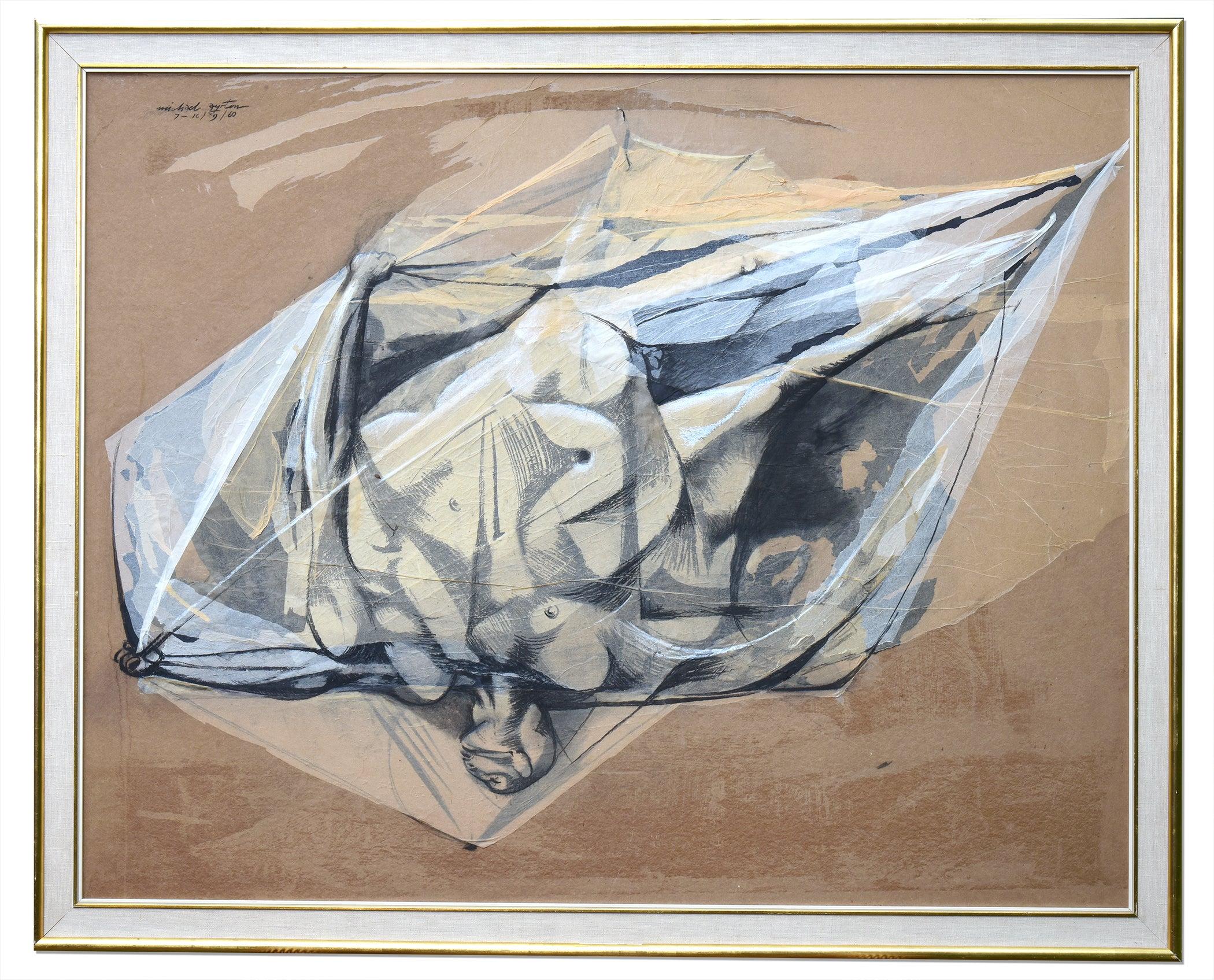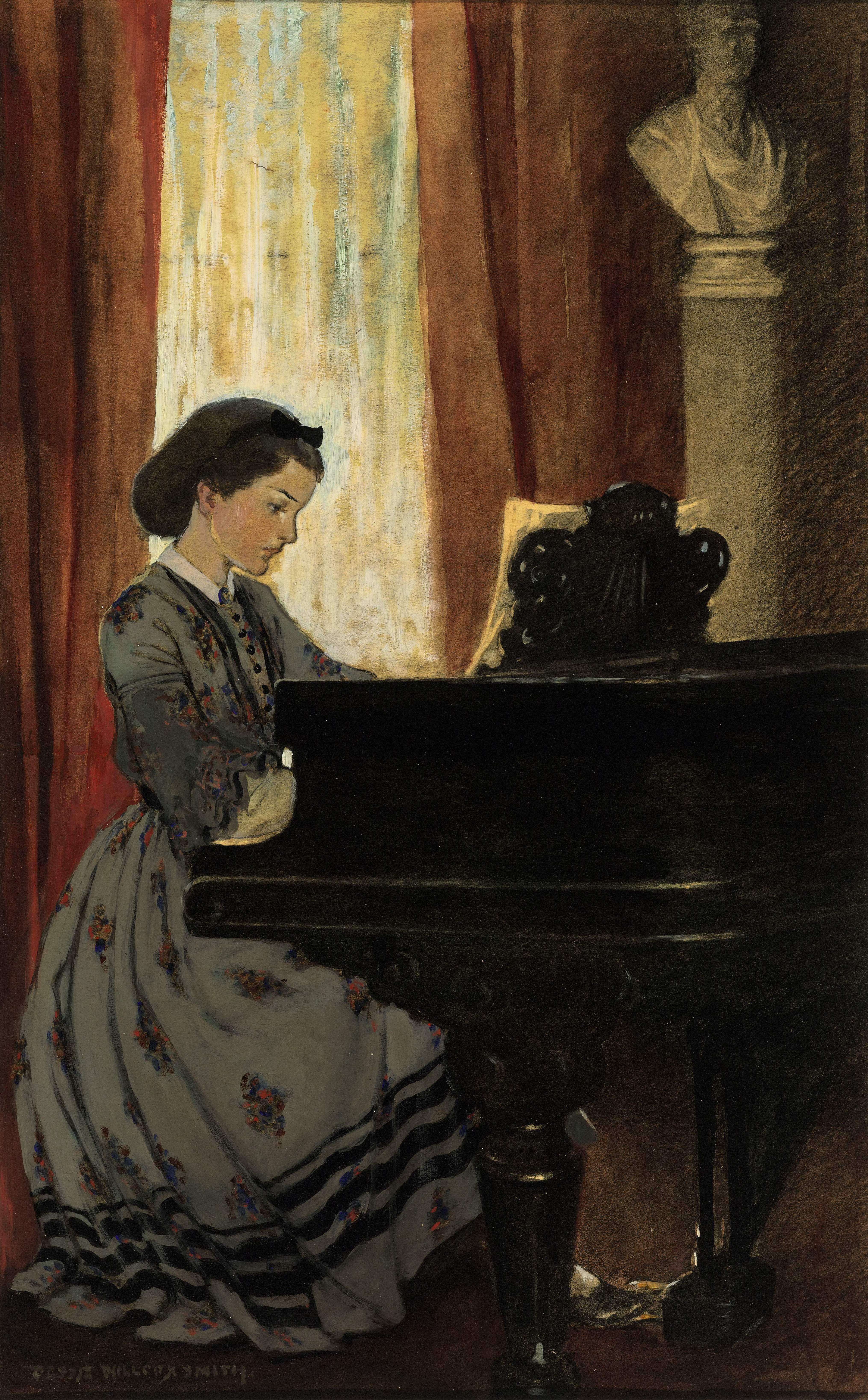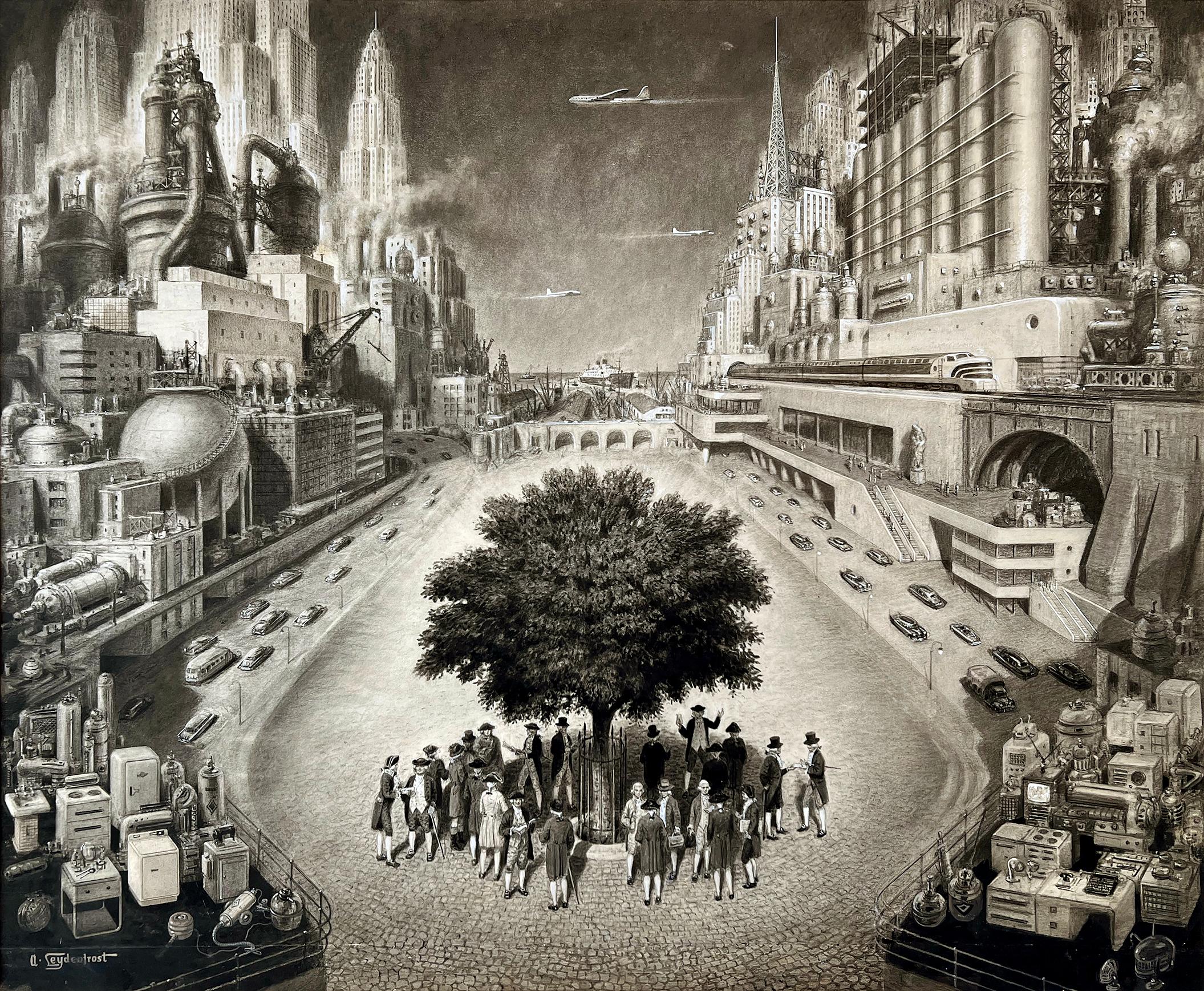Duilio BarnabeArlecchino in blu e grigio (Harlequin in Blue and Gray)c. 1958
c. 1958
About the Item
- Creator:Duilio Barnabe (1914 - 1961, Italian)
- Creation Year:c. 1958
- Dimensions:Height: 30.75 in (78.11 cm)Width: 24.4 in (61.98 cm)
- Medium:
- Movement & Style:
- Period:
- Condition:Note that the dimensions of the work itself are 25 ⅝ x 19 ⅝ in. The overall dimensions listed include the matt. The work is not framed.
- Gallery Location:Chicago, IL
- Reference Number:1stDibs: LU36533372841
Duilio Barnabe
Through elaborate still lifes, vivid landscape paintings and thought-provoking portraits reduced to bold geometric forms, Italian artist Duilio Barnabé (who often went by Dubè) embraced the Cubist genre with a zeal to match that of his greatest inspiration, Spanish master Pablo Picasso.
Born in Bologna in 1914, Barnabé showed a strong interest in art from an early age. In his youth, he studied under Italian modern artist Giorgio Morandi, developing his skill and trying to find his own unique style.
In 1935, the Italian government drafted Barnabé to military service, where he served a tour in North Africa. He married sculptor Angiola Cassanello in 1938, and served another stint in the military in 1940, after being called to duty once again. Upon his second return from service, Barnabé was finally able to make his art in earnest. He produced works that won the Baruzzi Prize in 1941 and the International Curlandese Prize in 1943.
In 1946, Barnabé moved to Paris, where he created the bulk of his early paintings, in which Picasso's influence strongly shone through. His major artistic debut occurred in 1947, at the exhibition of contemporary Italian art in Switzerland. Many exhibitions and awards followed, including a solo show at the Venice Biennale.
In 1955, he received a gold medal from the Italian government for a series of stained glass windows he had designed. Barnabé worked in many mediums, including furniture, but his primary focus was painting. He produced a large body of work until his death in 1961 in an auto accident in the Swiss Alps.
Find authentic Duilio Barnabé figurative paintings and other art on 1stDibs.
- ShippingRetrieving quote...Ships From: Chicago, IL
- Return PolicyA return for this item may be initiated within 7 days of delivery.
- St. SebastianBy Duilio BarnabeLocated in Chicago, ILThis painting is Barnabe's Modernist re-imagining of the dramatic Renaissance and Baroque paintings he would have known in his native Italy of St. Sebastian, an early Christian saint...Category
Mid-20th Century Modern Figurative Paintings
MaterialsCanvas, Oil
- Figura seduta (Seated figure)By Duilio BarnabeLocated in Chicago, ILThe painting is signed at the lower right by Barnabè. In 1959, French art critic Michel Concil-Lacoste, in the newspaper Le Monde, expressed his views on Barnabè: "Barnabè is a pain...Category
Mid-20th Century Modern Figurative Paintings
MaterialsCanvas, Oil
- Woman in a Red DressBy Béla CzóbelLocated in Chicago, ILIn an article published in Le Figaro (Paris, March 19, 1964), Raymond Cogniat comments on Czóbel’s unique artistic style. He writes: “...Czóbel, who arrived Paris in the first years...Category
1940s Expressionist Figurative Paintings
MaterialsCanvas, Oil
- Young Girl in PinkBy Béla CzóbelLocated in Chicago, ILBéla Czóbel, Paintings, Watercolors, Drawings, R. S. Johnson Fine Art, Chicago, 1996: no. 60 and reproduced on page 95 of catalogue.Category
1960s Expressionist Figurative Paintings
MaterialsCanvas, Oil
- Young Girl in GreenBy Béla CzóbelLocated in Chicago, ILIn a letter written to Czóbel after he had become quite ill in 1975, famous Portuguese painter Vieira da Silva writes: “My very dear Czóbel, We em...Category
1970s Expressionist Figurative Paintings
MaterialsCanvas, Oil
- Mazzo di fiori (Bouquet)By Duilio BarnabeLocated in Chicago, ILThis charcoal and gouache still-life is signed by Barnabè in the lower right. In 1959, French art critic Michel Concil-Lacoste, in the newspaper Le Monde, expressed his views on Bar...Category
1950s Modern Still-life Drawings and Watercolors
MaterialsCharcoal, Gouache
- Rare Modernist Hungarian Rabbi Pastel Drawing Gouache Painting Judaica Art DecoBy Hugó ScheiberLocated in Surfside, FLRabbi in the synagogue at prayer wearing tallit and tefillin. Hugó Scheiber (born 29 September 1873 in Budapest – died there 7 March 1950) was a Hungarian modernist painter. Hugo Scheiber was brought from Budapest to Vienna at the age of eight where his father worked as a sign painter for the Prater Theater. At fifteen, he returned with his family to Budapest and began working during the day to help support them and attending painting classes at the School of Design in the evening, where Henrik Papp was one of his teachers. He completed his studies in 1900. His work was at first in a post-Impressionistic style but from 1910 onward showed his increasing interest in German Expressionism and Futurism. This made it of little interest to the conservative Hungarian art establishment. However, in 1915 he met the great Italian avant-gardist Filippo Tommaso Marinetti and the two painters became close friends. Marinetti invited him to join the Futurist Movement. The uniquely modernist style that he developed was, however, closer to German Expressionism than to Futurism and eventually drifted toward an international art deco manner similar to Erté's. In 1919, he and his friend Béla Kádar held an exhibition at the Hevesy Salon in Vienna. It was a great success and at last caused the Budapest Art Museum to acquire some of Scheiber's drawings. Encouraged, Scheiber came back to live in Vienna in 1920. A turning point in Scheiber's career came a year later, when Herwarth Walden, founder of Germany's leading avant-garde periodical, Der Sturm, and of the Sturm Gallery in Berlin, became interested in Scheiber's work. Scheiber moved to Berlin in 1922, and his paintings soon appeared regularly in Walden's magazine and elsewhere. Exhibitions of his work followed in London, Rome, La Paz, and New York. Scheiber's move to Germany coincided with a significant exodus of Hungarian artists to Berlin, including Laszlo Moholy-Nagy and Sandor Bortnyik. There had been a major split in ideology among the Hungarian avant-garde. The Constructivist and leader of the Hungarian avantgarde, Lajos Kassák (painted by Hugó Scheiber in 1930) believed that art should relate to all the needs of contemporary humankind. Thus he refused to compromise the purity of his style to reflect the demands of either the ruling class or socialists and communists. The other camp believed that an artist should be a figurehead for social and political change. The fall out and factions that resulted from this politicisation resulted in most of the Hungarian avant gardists leaving Vienna for Berlin. Hungarian émigrés made up one of the largest minority groups in the German capital and the influx of their painters had a significant effect on Hungarian and international art. Another turning point of Scheiber's career came in 1926, with the New York exhibition of the Société Anonyme, organized by Katherine Dreier. Scheiber and other important avant garde artists from more than twenty-three countries were represented. In 1933, Scheiber was invited by Marinetti to participate in the great meeting of the Futurists held in Rome in late April 1933, Mostra Nazionale d’Arte Futurista where he was received with great enthusiasm. Gradually, the Hungarian artists began to return home, particularly with the rise of Nazism in Germany. Kádar went back from Berlin in about 1932 and Scheiber followed in 1934. He was then at the peak of his powers and had a special flair in depicting café and cabaret life in vivid colors, sturdily abstracted forms and spontaneous brush strokes. Scheiber depicted cosmopolitan modern life using stylized shapes and expressive colors. His preferred subjects were cabaret and street scenes, jazz musicians, flappers, and a series of self-portraits (usually with a cigar). his principal media being gouache and oil. He was a member of the prestigious New Society of Artists (KUT—Képzőművészek Új Társasága)and seems to have weathered Hungary's post–World War II transition to state-communism without difficulty. He continued to be well regarded, eventually even receiving the posthumous honor of having one of his images used for a Russian Soviet postage stamp (see image above). Hugó Scheiber died in Budapest in 1950. Paintings by Hugó Scheiber form part of permanent museum collections in Budapest (Hungarian National Museum), Pecs (Jannus Pannonius Museum), Vienna, New York, Bern and elsewhere. His work has also been shown in many important exhibitions, including: "The Nell Walden Collection," Kunsthaus Zürich (1945) "Collection of the Société Anonyme," Yale University Art Gallery, New Haven, Connecticut (1950) "Hugó Scheiber: A Commemorative Exhibition," Hungarian National Museum, Budapest (1964) "Ungarische Avantgarde," Galleria del Levante, Munich (1971) "Paris-Berlin 1900-1930," Centre Georges Pompidou, Paris (1978) "L’Art en Hongrie, 1905-1920," Musée d’Art et l’Industrie, Saint-Etienne (1980) "Ungarische Avantgarde in der Weimarer Republik," Marburg (1986) "Modernizmus," Eresz & Maklary Gallery, Budapest (2006) "Hugó Scheiber & Béla Kádár," Galerie le Minotaure, Paris and Tel Aviv (2007) Hugó Scheiber's paintings continue to be regularly sold at Sotheby's, Christie's, Gillen's Arts (London), Papillon Gallery (Los Angeles) and other auction houses. He was included in the exhibition The Art Of Modern Hungary 1931 and other exhibitions along with Vilmos Novak Aba, Count Julius Batthyany, Pal Bor, Bela Buky, Denes Csanky, Istvan Csok, Bela Czobel, Peter Di Gabor, Bela Ivanyi Grunwald, Baron Ferenc Hatvany, Lipot Herman, Odon Marffy, C. Pal Molnar...Category
Early 20th Century Modern Figurative Paintings
MaterialsPaper, Charcoal, Pastel, Watercolor, Gouache
- "Icarus Suspended" Abstract Mythical Figurative Mixed MediaBy Michael AyrtonLocated in Detroit, MI“Icarus Suspended” is an extraordinary painting of Ayrton's obsession with flight, myths, mirrors and mazes. This complex piece shows a figure in flight, frozen in action, either swooping down or, perhaps, falling to earth. Named after the Greek mythological figure, Icarus, who along with his father attempted to escape from Crete by means of wings that his father constructed from feathers and wax. Flying too close to the sun the wax melted and both fell to earth. The positioning of Ayrton's figure is reminiscent of "The Fall of Icarus" by Jacob Peter Gowy, Museo Nacional del Prado. This is part of a series of artworks on Icarus some sculptural and some three-dimensional paintings on canvas. Verso contains gallery label Matthiesen Gallery, 142 Bond St., London, England, with a signature and text in upper right corner: "To Morton Schotnick. Bought on the occasion of The Archives of American Arts Tour to London, England. October 10, 1961. Michael Ayrton...Category
1960s Modern Abstract Paintings
MaterialsCharcoal, Mixed Media, Gouache, Board
- The Great Drawing- Room Was Haunted by a Tuneful Spirit That Came and WentBy Jessie Willcox SmithLocated in Fort Washington, PADate: 1915 Medium: Watercolor, Gouache and Charcoal on Board Dimensions: 26.25" x 16.50" Signature: Signed Lower Left LITERATURE Louisa May Alcott,...Category
1910s Mixed Media
MaterialsCharcoal, Watercolor, Gouache, Board
- Futurist Vision - Mid-Century New York Skyline - Industrial ProgressLocated in Miami, FLRarely do you come across a work of art that is vastly different than just about anything you see. This work is undeniably brilliant and a sheer pleasure to behold. Alexander Leydenfrost...Category
1950s Art Deco Landscape Paintings
MaterialsGouache, Charcoal, Graphite, Board
- Black and White Nude Woman in Acrylic, Gouache, and Charcoal on PaperLocated in Soquel, CABlack and White Nude Woman in Acrylic, Gouache, and Charcoal on Paper Black and white painting of a woman by acclaimed bluegrass musician Katherine ...Category
1970s Contemporary Figurative Paintings
MaterialsCharcoal, Gouache, Acrylic, Paper
- Encaustic Figurative 1960's Gloria DudfieldBy Gloria DudfieldLocated in Arp, TXGloria Dudfield (1922 – 2015) Untitled c.1960's Encaustic and charcoal on paper 16"x18" Unsigned Came from a portfolio of her work in the San Francisco Bay Area. Gloria had a Mast...Category
Mid-20th Century Abstract Figurative Paintings
MaterialsEncaustic, Gouache, Charcoal






